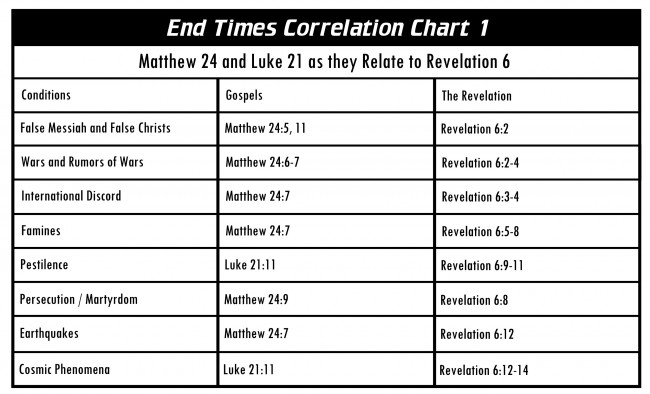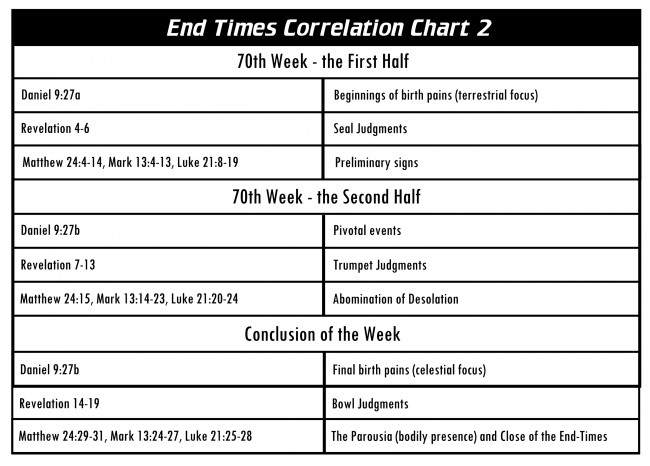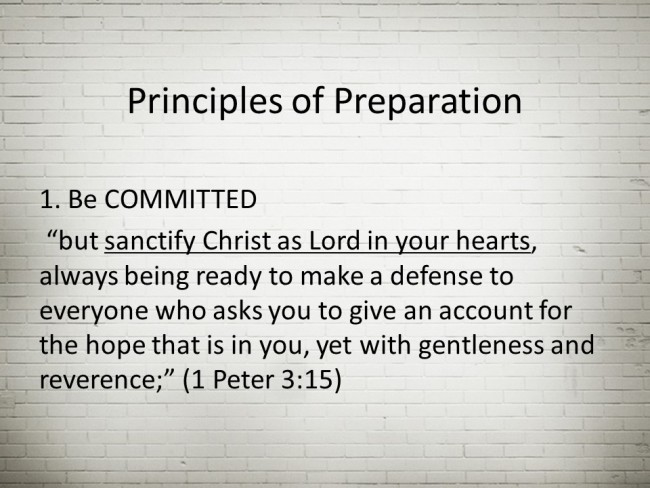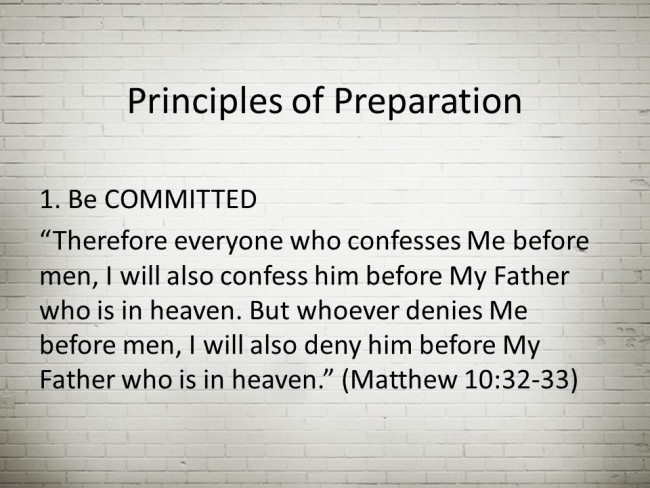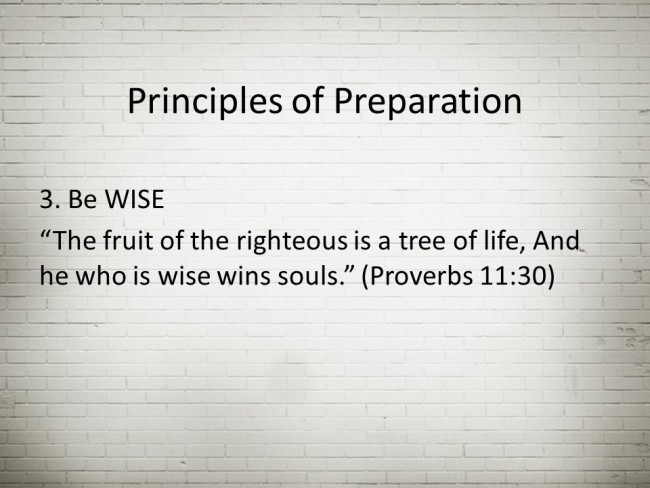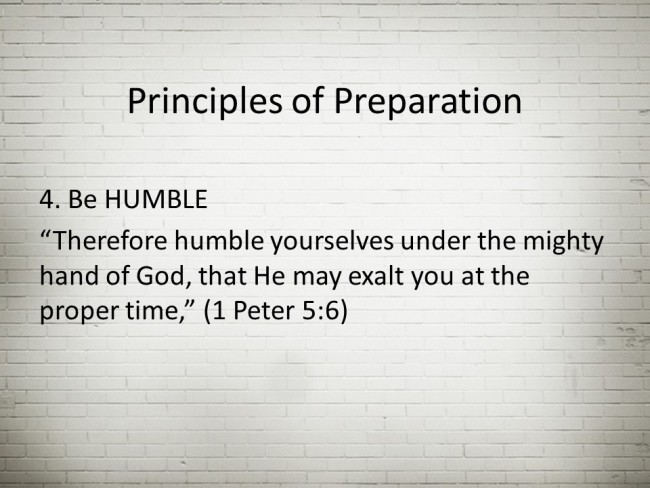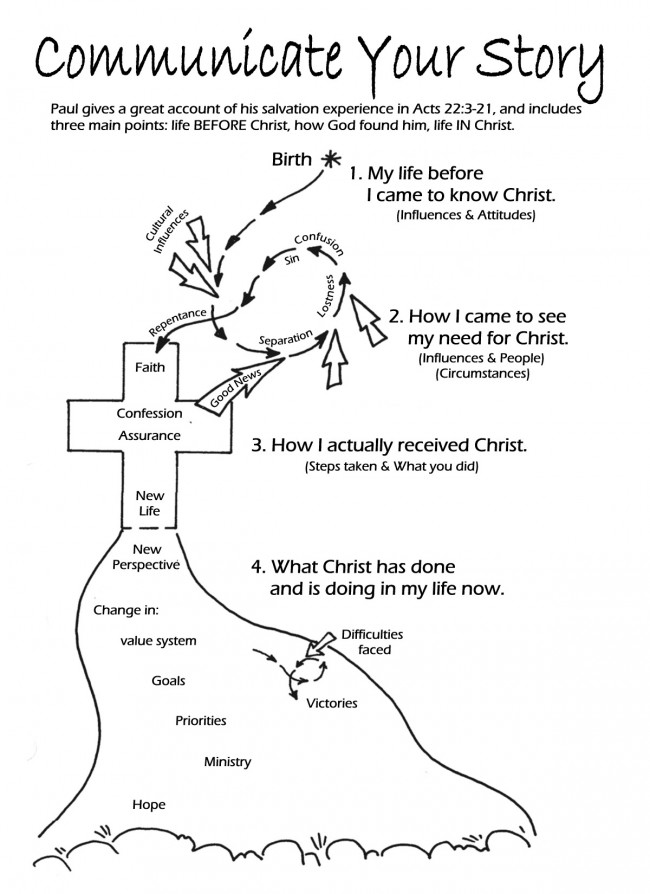This lesson is all about How to be Ready for the End-times. While I am a proponent of the A-millennial view of the end times, much of this teaching is part of the Pre-millennial Dispensational position. When you hear John Hagee or Tim LaHaye, or read the Left Behind series, they’re talking about end-times prophecy from this point of view.
To better understand the A-millennial view, read Ray Summers little book called, “Worthy is the Lamb,” Broadman Press, 1951. Also, I will post My Notes on Daniel and My Notes of the Revelation at a later date.
Main Verse: Matthew 24:44 – For this reason you also must be ready; for the Son of Man is coming at an hour when you do not think He will.
Passages we will consider: Matthew 24:1-51; Mark 13:1-37; Luke 21:5-36
Purpose: The purpose of this study is to develop the character quality of readiness (preparedness, watchfulness) in anticipation of Christ’s return. Scripture teaches that anticipating Christ’s return motivates us to live in light of eternity (1 Corinthians 15:29-34); causes us to keep ourselves pure (1 John 3:2,3); provides steadfastness inspired by hope (1 Thessalonians 1:3,10); and promises a reward for loving His appearing (2 Timothy 4:8).
Historical Background: Jesus’ instruction to His disciples from the Mount of Olives (Mount Olivet, giving it the name the Olivet Discourse) appears in Matthew 24-25; Mark 13; and Luke 17:20-37. It is one of the Bible’s most important texts because it not only provides the Lord’s final discourse but also His most extensive prophetic teaching.
Much prophetic confusion has resulted from a failure to understand that the Olivet Discourse involves Israel, not the church, and refers to a future (eschatological) age, not the past or present one.
The chronologically of this narrative (Mark 12:28-34) occurs the Wednesday before the crucifixion and immediately after Jesus brought eight “woes” against the leaders of the nation of Israel (Matthew 23:13, 14, 15, 16, 23, 25, 27, 29).
Jesus uses five illustrations to answer the specific questions of the disciples: “‘When will these things be? And what will be the sign of Your coming, and of the end of the age?”‘ (Matthew 24:3).
Like any other passage of Scripture, the Olivet Discourse (Jesus’ answer to these questions) must be interpreted in context. Matthew wrote his Gospel to Jewish people to present divinely attested proof that Jesus (Yeshua) was the legitimate heir to the Davidic throne and that His Messianic claims were true and justified.
Commanded in the Gospels: Matthew 24:42 (Be on the alert), Matthew 24:43 (Be sure of this) – literally “know this,” Matthew 24:44 (Be ready), Matthew 25:13 (Be on the alert), Mark 13:33 (Take heed, Keep on the alert), Mark 13:35 (Be on the alert), Mark 13:37 (Be on the alert). Christ also used five parables to teach the importance of being ready for His second coming:
- Thief – Matthew 24:43
- Faithful slave – Matthew 24:45-51
- Ten virgins Matthew 25:1-12
- Talents – Matthew 25:14-30
- Doorkeeper – Mark 13:34-36
End times information is found in the Book of Acts (Acts 1:6-7) and the Epistles (1 Thessalonians 5:1- 11; 2 Peter 3:10; Revelation 3:3,1 1;22:7,12,20)
Discussion Questions:
1. What motivated the disciples to point out the temple buildings to Jesus? (Matthew 24:1) Aware of Jesus’ pronouncement against the nation and particularly the Temple establishment (He had just said, “Behold, your house [Temple] is being left to you desolate” – Matthew 23:37-38) the disciples perhaps thought a reminder of the national unity symbolized by the Temple might temper Jesus’ disposition toward national judgment.
A few days earlier, Christ had referred to the temple as His Father’s “house” (Matthew 21:13) but the blessing and glory of God were being removed from Israel (see 1 Samuel 4:21). When Christ “departed from the temple” (Matthew 24:1), the glory of God went with Him. Ezekiel 11:23 describes Ezekiel’s vision of the departure of the Shekinah glory in His day. The glory left the temple and stood on the Mount of Olives.
The disciples were also impressed, as were most in that day, with the Temple’s unrivaled magnificence, which had become a source of national pride: “Some were talking about the temple, that it was adorned with beautiful stones and votive gifts (donations)” (Luke 21:5-6). The disciples made their national statement to Jesus as He left the Temple. While waiting for Him they began pointing out the latest structural additions to the compound, which (according to John 2:20) had been in process for 46 years: “Teacher, behold what wonderful stones and what wonderful buildings!” (Mark 13:1).
Maybe they were trying to comprehend Jesus’ judicial remarks, but then Jesus states that all of the stones they had shown Him would be violently torn down at the time of judgment. Matthew 24:2 says, “And He said to them, “Do you not see all these things? Truly I say to you, not one stone here will be left upon another, which will not be torn down.”
2. What were the two questions that the disciples asked Jesus privately? (Matthew 24:3)
- “When will these things happen?”
- “What will be the sign of your coming, and of the end of the age?”
The first question concerned the specific time of the Temple’s destruction: the second (composed of two related parts) concerned “the sign” that would mark Jesus’ advent to Israel (parousia, “bodily presence”) as Messiah at the end of the age. Jesus’ response to these questions forms the prophetic teaching called the Olivet Discourse. The first question is addressed in Luke 21:10-24 and the second is addressed in Matthew 24:4-31 and Mark 13:1-27.
3. What event fulfilled Jesus’ prophetic prediction that “not one stone here will be left upon another, which will not be tom down“? (Luke 21:10-24) When Titus came down in AD 70, he burned the Temple. The foundation stones were made of marble overlaid with gold. As the temple burnt the gold melted and ran down between the cracks in the rocks. The Roman soldiers had to dismantle every stone in order to get to the gold. This “near prophecy” was fulfilled in 70 AD and provided hope that the “far prophecy” would be fulfilled. Prophets would often give a “near prophecy” to validate their credentials as a prophet. Anyone could predict all kinds of things way off in the future.
4. When the disciples spoke of “the end of the age,” to what were they referring? (Matthew 24:3) Christ was not referring to the end of the church age but the end of the age for Israel before the Messiah’s return. The church at this point in time doesn’t even exist. It was started by Christ baptizing believers by the Holy Spirit into a new thing called “the Body of Christ” on the day of Pentecost (Acts 1:5; 2:1-4; 11:13-16; 1 Corinthians 12:13). The church age was a mystery that wasn’t revealed in the Old Testament.
Jesus had already prophetically talked about “the end of the age” (Matthew 13:40,49) for the nation of Israel. In the Parable of the Tares (Matthew 13:24-30, 36-43) Jesus talks about “the end of the age” (Matthew 13:39,40, 13:49) that occurs right before the establishment of the millennial kingdom.
When Jesus explained this parable, He taught that at the end of the age the angels will take all unbelievers away to be burned and all the righteous believers will remain on the earth to be “barned” in the millennial kingdom. The parable of the dragnet (Matthew 13:47-50) teaches the same truth.
5. What will be the “signs” of Christ’s Second Coming? (Matthew 24:4-8) This passage describes the signs, “birth pains” or divine judgments of the first half of the tribulation period, and Matthew 24:14 is the global evangelization that will be accomplished by the midpoint of this period. Remember, this is according to the Pre-millennialism.
Jesus stated that these judgments are not “the end” of the judgments but merely the “beginning” (Matthew 24:8). After “beginning birth pains,” the more intense birth pains come that climax the birth process. Since the tribulation does not immediately begin after the rapture of the church, but begins with the commencement of Daniel’s 70th week (Daniel 9:27), these verses cannot describe events within the Church Age.
The most compelling argument for a Tribulation context for these verses comes from a comparison of Matthew 24:4-13 with the first five seal judgments in Revelation 6.
Neither can these signs be used by the church as “signs of the times” to indicate the nearness of the Lord’s coming. Many Christians have used the apparent increasing frequency of earthquakes, apostasy in the church, and moral decline in society in general as indicators that we are fast approaching the rapture and the end-times. However, the rapture is a signless event; and these birth pains do not begin until Israel enters “the time of Jacob’s trouble” (Jeremiah 30:7). Since we do not know how long this will be after the rapture, we must exercise caution in trying to predict the nearness of end-times events based on the presence of these conditions in the present age (Matthew 24:9-14).
6. Does Matthew 24:13 teach that we can lose our salvation? Taken out of context this verse could be used to deny eternal security. There is no reference to redemption or salvation here. The word saved (sothesetai) is eschatological and not soteriological. This verse promises that Christ will rescue those who endure to the end of the tribulation period; then He will usher them into the millennial age. This same concept is repeated in Matthew 24:21-22.
7. Will every unbeliever hear the gospel before the rapture of the church? (Matthew 24:14) The answer is no. This is a reference to the end of the tribulation period and not to the end of the church age. In context this verse teaches that the good news about the kingdom will be presented throughout the tribulation period, and then the end will come. In fact this verse promises that every earth dweller will hear the “gospel of the Kingdom” before Christ returns. Some teach the gospel of the kingdom will probably be proclaimed by the 144,000 Jewish evangelists (Revelation 14:1).
8. What does Jesus say to look for to know that the Great Tribulation has begun? (Matthew 24:15-20) The phrase “the ABOMINATION OF DESOLATION” originally referred to the desecration of the temple by Antiochus Epiphanes, king of Syria in the second century BC. Antiochus invaded Jerusalem in 168 BC, made the altar into a shrine to Zeus, and even sacrificed pigs on it.
However, Jesus clearly was looking toward a yet-future “abomination of desolation.” Some suggest that this prophecy was fulfilled in AD 70 when Titus invaded Jerusalem and destroyed the temple. However, the Apostle Paul saw a still-future fulfillment (2 Thessalonians 2:3-4), as did John (Revelation 13:14-15) when the Antichrist sets up an image in the temple during the future tribulation period. Christ’s words here therefore look beyond the events of AD 70 to a time of even greater global cataclysm that will immediately precede his coming (Matthew 24:29-31).
The Abomination of Desolation involves God being replaced with man in the Most Holy Place of the temple. We are told in Scripture that when the Antichrist is empowered by Satan (Revelation 13:1-4) he will enter the Jewish temple and claim to be god (2 Thessalonians 2:3-4). He then makes war with Israel (Revelation 12:13-17). This act by the Antichrist ushers in the “Great Tribulation” (Matthew 24:21).
9. Who will gain the greatest benefit in reading this discourse? (Matthew 24:15) Both Matthew and Mark (Mark 13:14) tell the reader to consider this text as a means to understanding the prophecy of the Olivet Discourse. This portion of Scripture will be a manual for tribulation saints, complete with a list of imperatives of what to do when they see the Antichrist go into the temple and establish himself in place of the one true God (Matthew 24:16-20).
Many prophetic teachers believe that the command to “flee into the mountains” is a reference to “Petra” (Revelation 12:14). Petra becomes a wilderness and mountainous “hiding place” for the Jewish people. Petra is hidden in the barren mountains of southern Jordan. It is a city that once ranked with almost any in the ancient world. Petra was carved from richly colored sandstone at the crossing of key caravan routes and thrived for a thousand years before it was devastated by earthquakes. Drifting sand covered the ruins.
Note the reference to the Sabbath (Matthew 24:20) which would be of no concern to the church (Colossians 2:16) but of great importance to orthodox Jews who are bound to keep the Sabbath as a perpetual covenant (Exodus 31:13,16; 35:2; Deuteronomy 5:12-15; Numbers 15:32-36). We have a reference to the distance a Jew was allowed to travel in Acts 1:12 “Then they returned to Jerusalem from the mount called Olivet, which is near Jerusalem, a Sabbath day’s journey away.” A Sabbath day’s journey was 2,000 cubits or approximately 3/5 of a mile.
10. How did Jesus use the 70th week of Daniel as a template to answer the disciples’ question? Jesus used the 70th week prophecy as the template for the chronological events He unfolded in His response to the disciples’ questions. This also applies to the judgment section of Revelation (chapters 4-19) where Jesus, the one who gave the Revelation vision to the Apostle John (Revelation 4; Daniel 7:25; 12:7,11,12).
Viewing these texts together (see Correlation Chart 2 below), we find that the “beginning” birth pains of Matthew 24:4-14 correlate with the seal judgments of Revelation 4-6, which…
- Have a terrestrial focus;
- Fit within the first half of Daniel’s 70th week (Daniel 9:27a); and
- Climax with the pivotal event of the Temple’s desecration (abomination of desolation) in Matthew 24:15 and Mark 13:14, the midpoint of Daniel’s 70th week (Daniel 9:27b).
Events then intensify to concluding birth pains in Matthew 24:16-26, which…
- Correlate with Revelation 7-19,
- Have a celestial focus, and
- Climax with the heavenly appearing of “the sign” of Messiah’s advent to earth in judgment (Matthew 24:27-31; Revelation 19).
These events fit within the last half of Daniel’s 70th week (Daniel 9:27b), which concludes with the destruction of the temple’s desolator (“the prince who is to come,” the Antichrist, Daniel 9:26).
If Matthew 24:4-14 predict signs that are for the future tribulation period and relate primarily to the Jewish people of that day, they cannot have had a past fulfillment, especially not with the fall of Jerusalem in AD 70. Comparing the events in these verses reveals that they cannot be identified with first-century historical events.
11. How would you describe the nature of the Great Tribulation? (Matthew 24:21-28) The words “has not occurred” and “nor ever will,” along with the description that follows, identify this as the yet-future time in which God’s wrath shall be poured out upon the earth (see Revelation 7:14). Jesus’ descriptions of the cataclysms that follow closely resemble the outpouring of divine wrath described in the bowl judgments of Revelation 16 and his subsequent appearing in Revelation 19.
Old Testament writers predicted the Great Tribulation in similar terms.
- Daniel 12:1 – “Now at that time Michael, the great prince who stands guard over the sons of your people, will arise And there will be a time of distress such as never occurred since there was a nation until that time; and at that time your people, everyone who is found written in the book, will be rescued.”
- Jeremiah 30:7 – “Alas! For that day is great, there is none like it; and it is the time of Jacob’s distress, but he will be saved from it.”
- Matthew 24:22 – “Unless those days had been cut short, no life would have been saved; but for the sake of the elect those days will be cut short.“
Jesus indicates that if God in eternity past had not determined to cut short the second half of the tribulation to three and 1/2 years, all flesh would perish. For mankind to survive, God determined to prevent the time of “Great Tribulation” from running indefinitely beyond the time limit He had set.
Jesus’ statement implied that this period will be the unparalleled time of trouble for all flesh (Jewish and Gentile) on Earth. For several reasons, this fact prevents the “Great Tribulation” from referring to the Roman Empire’s destruction of Jerusalem, the second Temple, or Israel as a nation-state in A.D. 70:
- Only Jewish flesh was threatened in A.D. 70.
- The A.D. 70 destruction was not worse than that of Samaria and the northern kingdom of Israel as a nation-state in 722 B.C. or the destruction of Jerusalem, the first Temple, and the kingdom of Judah as a nationstate in 586 B.C.
- The destruction of A.D. 70 was not worse than the Holocaust of World War II. Four times as many Jewish people were killed in the Holocaust than in the war that ended in A.D. 70.
12. How does Satan mislead people during the Tribulation Period? (Matthew 24:4,5,11,23-28) Jesus warns his audience to “see to it,” which denotes “to keep your eyes open” that “no one misleads you” (Matthew 24:4; Mark 13:5). Jesus speaks of the future reality that many will be misled (Matthew 24:5, 11 ,24; Mark 16:6). The verb “mislead,” in the active voice means “to deceive by leading into error,” and in the passive voice “to go astray, wander,” (Vines pg.151). These false Christs and false prophets are wandering or shooting-stars that are no longer in a sound doctrine orbit. Jesus warns against false prophets who set forth false Messiahs. These false Messiahs will attempt to establish their credibility through counterfeit sign miracles. Matthew 24:24 says “For false Christ’s and false prophets will arise and will show great signs and wonders, so as to mislead, if possible, even the elect” (cp. Mark 13:22).
Most of the charismatic gifts today are unsimilar to those of the apostolic period. The charismatic sign gifts today are not limited to the Christian church. These experiences transcend denominational lines and are even present in different world religions and cults today. A case in point is the experience of those in the New Age movement who have the Kundalini spirit.
The Kundalini spirit has invaded the church masquerading as the Holy Spirit. It appears that these ecumenical “spirit experiences” may be one of the unifying factors that can bring together a one world religion under the Antichrist after the true church has been raptured. Satan is the source of this end time deception (Revelation 12:9; 13:14; 18:23; 19:20; 20:3, 8, 10).
2 Thessalonians 2:7-10 For the mystery of lawlessness is already at work; only he who now restrains will do so until he is taken out of the way. 8 Then that lawless one will be revealed whom the Lord will slay with the breath of His mouth and bring to an end by the appearance of His coming; 9 that is, the one whose coming is in accord with the activity of Satan, with all power and signs and false wonders, 10 and with all the deception of wickedness for those who perish, because they did not receive the love of the truth so as to be saved.
Revelation 13:11-14 Then I saw another beast coming up out of the earth; and he had two horns like a lamb and he spoke as a dragon. 12 He exercises all the authority of the first beast in his presence And he makes the earth and those who dwell in it to worship the first beast, whose fatal wound was healed. 13 He performs great signs, so that he even makes fire come down out of heaven to the earth in the presence of men. 14 And he deceives those who dwell on the earth because of the signs which it was given him to perform in the presence of the beast, telling those who dwell on the earth to make an image to the beast who had the wound of the sword and has come to life.
13. Does Matthew 24:29-31 refer to the Rapture or the Glorious Appearance at the end of the Tribulation Period? (Matthew 24:29-31) The Second Advent or Coming of Christ has two phases. The first phase is the “rapture of the church” before the tribulation period and the second phase is called the “revelation” that occurs at the end of the Tribulation Period. These two “comings” are clearly contrasted on the chart below.
14. What is the sign of the Son of Man’s Coming? (Matthew 24:30) The Son of Man himself is the sign. The events described here precisely parallel the description in Daniel 7:13; Revelation 19:11-21 . The phrase “all the tribes of the earth will mourn” refers to people of different nationalities who mourn over their own rebellion. Israel in particular will mourn over their rejection of the Messiah (Zechariah 12:10-12).
15. What are the five illustrations that Jesus uses to illustrate the importance of being ready for Christ’s return? (Matthew 24:32-25:30) Jesus instructed His disciples to “be ready” for His return. Christ used five illustrations to make His point:
- The Parable of the Fig Tree (Matthew 24:32-35)
- The Days of Noah (Matthew 24:36-39)
- The Faithful and Evil Slave (Matthew 24:45-51)
- The Ten Virgins (Matthew 25:1-13)
- The Parable of the Talents (Matthew 25:14-30)
Just as windows let in sunlight, so illustrations illuminate the soul. With delicate yet direct statements, Jesus directed His disciples to God’s divine purposes and disclosed predictive prophetic events that will involve Israel as a nation.
16. What is Jesus trying teach through the parable of the fig tree? (Matthew 24:32-35) Matthew 24:34 says, “Truly I say to you, this generation will not pass away until all these things take place.” Jesus was not referring to the generation of his disciples who listened to him then. This fact is obvious from Matthew 21 :43, where he said, “The kingdom of God will be taken from you and given to a nation bearing the fruits of it.” Historically, the first-century generation would pass away, but the generation of Jewish people living when these signs begin will survive that period and see Messiah come as the King of glory. Yeshua’s promise is certain. It is easier for heaven and earth to pass away than for the King’s words to fail (Matthew 24:35; 5:18).
This parable is also not referring to the generation when Israel became a state in 1948. The text is describing the tribulation generation. The fig tree is a sign of approximation. When the generation that is alive sees the signs listed in these verses they can be confident that Christ’s return will be in their lifetime. Just as tender fig branches that put forth their leaves on the fig tree act is a sign that summer is near, so the signs in this passage tell us that Christ’s second coming is soon. The generation that sees these signs won’t know the precise hour or day but the general period of time (Matthew 24:36).
Unfortunately these verses have been misused to determine the timing of the return of Christ. Some prophetic teachers of the past predicted that the rapture would occur in 1981 . Their rational was that the fig tree represents Israel who became a nation in 1948. If you add a generation (40 years) onto 1948 it adds up to 1988. If we subtract a 7 year tribulation period you would have Christ returning for the church in 1981 (The Late Great Planet Earth by: Hal Lindsey, Bantam Books, 1970, pg.43).
17. How can we know the exact time when Christ returns? (Matthew 24:36) Jesus said, “But of that day and hour no one knows, not even the angels of heaven, nor the Son, but the Father alone.” Jesus declared categorically that no one knows the “day and hour” of Christ’s return. The signs He had just been describing will be conclusive proof that his arrival is very near. Once they have begun, the general time period of his return will be known, because one of the key purposes of the signs will be to make it known. But even during those sign-days the precise “day and hour” of Jesus’ appearing will not be known, a truth he reiterates several times in this Olivet Discourse (see Matthew 24:42, 44, 50; 25:13).
Neither will the supernatural world know the precise time, not “even the angels of heaven.” Although the righteous angels enjoy intimacy with God, hovering around His throne to do his bidding (Isaiah 6:2-7) and continually beholding his face (Matthew 18:10), they are not privy to this secret. The angels will be directly and actively involved in the end time as God’s agents to separate the saved from the unsaved (see Matthew 13:41, 49), but for his own reasons God the Father will not reveal in advance exactly when he will call them into that service.
Still more amazingly not even “the Son” knew at the time he spoke these words or at any other time during his incarnation. Although he was fully God as well as fully man (John 1:1, 14), Christ voluntarily restricted his use of certain divine attributes when he became flesh. “Although He existed in the form of God, [He] did not regard equality with God a thing to be grasped,” that is, to be held onto during his humanness (Philippians 2:6). It was not that he lost any divine attributes but that he voluntarily laid aside the use of some of them and would not manifest those attributes except as directed by his Father (John 4:34; 5:30; 6:38).
18. How does Jesus’ second illustration stress the importance of readiness? (Matthew 24:37-42) Notice that the people in the days of Noah went about their lives while judgment was coming. In total disregard for Noah’s warning (2 Peter 2:5) the people of his day were unconcerned and went about their business as usual. When the flood came who was taken? The unbelievers were taken and the righteous remained on the earth. In the same way when Christ comes the unbelievers will be taken and “burned” (Matthew 13:40-42) but the believers will be left on planet earth to be “barned” (Matthew 13:43) in the Kingdom. This is in contrast to the rapture when believers are taken and unbelievers are left behind to face God’s wrath in the tribulation period. Remember that Jesus is speaking about the Jewish people (not the church) and the consummation of the age for the nation of Israel as they finish out the 70th week of Daniel in preparation for millennial kingdom.
Jesus says, “Therefore,” in view of this illustration you ought to be “be on the alert (present imperative), for you do not know which day your Lord is coming”(Matthew 24:42). The phrase “be on the alert” translates a present imperative, indicating a call for continual expectancy.
19. What characteristics demonstrate readiness in Jesus’ third illustration? (Matthew 24:43-51) In the illustration of the faithful and evil slave, Jesus stresses the importance of being ready in case he comes sooner than anticipated (Matthew 24:43-51). His point here is alertness, vigilance, readiness, preparedness in light of his sudden return. The Lord is coming, and his coming will test his slaves. The illustration is simple, yet sublime. Just as the master in Jesus’ story entrusted all his possessions to his slave, so the God of Israel has entrusted all things in the earth to his slaves. A slave’s response to his Lord reveals the true condition of the slave’s heart (Matthew 24:46, 48-49). The Lord wants to find his slaves faithfully doing his will (Matthew 24:45-46). When the Lord returns, he will reward faithfulness (Matthew 24:47). Failure to do the Lord’s bidding is faithless stewardship and brings the Lord’s just punishment because, in the parable, when such a slave noted his master’s delay, he abused his own slaves. Yet the master returned to the house unexpectedly, and judgment came (Matthew 24:50-51).
In the Lord’s eyes, that slave was a hypocrite. Thus he was separated from the others and consigned to eternal judgment, where there is “weeping and gnashing of teeth” (Matthew 13:42). Likewise, at the Messiah’s second coming, the wicked will be judged and separated eternally from God.
These parables of the faithful and evil slave and the talents given them by the master speak of the privileges God has given to his covenant people Israel and the consequences of willful and prolonged disobedience.
“But be sure of this (present imperative), that if the head of the house had known at what time of the night the thief was coming, he would have been on the alert and would not have allowed his house to be broken into. 44 For this reason you also must be ready (present imperative) for the Son of Man is coming at an hour when you do not think He will.” (Matthew 24:43-44)
As no one knows what hour the thief will come, no one knows the hour of the Lord’s return or the Day of the Lord that accompanies his coming (1 Thessalonians 5:2; 2 Peter 3:10). But the believer is to be ready at all times.
The evil slave represents an unbeliever who refuses to take seriously the promise of Christ’s return (2 Peter 3:4). Though he is an unbeliever (as demonstrated by his punishment – Revelation 22:13), he is still accountable to Christ for the stewardship of his time. Jesus was teaching that every person in the world holds his life, natural abilities, wealth, and possessions in trust from God and must give account of how these things are used.
“Who then is the faithful and sensible slave whom his master put in charge of his household to give them their food at the proper time? 46 Blessed is that slave whom his master finds so doing when he comes. 47 Truly I say to you that he will put him in charge of all his possessions.” (Matthew 24:45-47)
The believer who is found faithful to the Lord in what he has been given will be given charge of all of the Lord’s possessions, having inherited the absolute fullness of the kingdom of God as a fellow heir of Jesus Christ.
Jesus said, “But if that evil slave says in his heart, ‘My master is not coming for a long time, 49and begins to beat his fellow slaves and eat and drink with drunkards“‘ (Matthew 24:48,49)
The evil activities Jesus then mentions, the beating of “fellow slaves” and eating and drinking “with drunkards,” are not meant to characterize every unbeliever during the tribulation, but those activities reflect the attitude many of them will have. Because they think the Lord will not come “for a long time” (Matthew 24:48), they will feel free to indulge themselves in whatever sins and pleasures they desire.
Jesus said, “the master of that slave will come on a day when he does not expect him and at an hour which he does not know 51and will cut him in pieces and assign him a place with the hypocrites; in that place there will be weeping and gnashing of teeth.” (Matthew 24:50-51)
In this case the master will not come as Savior and King to bless and to reward but will come as Judge and Executioner to condemn and to destroy. He will cut the unbelieving slave in pieces and assign him a place with the hypocrites in eternal fire.
The phrase “cut…in pieces’ literally means to cut into two parts. It is used in that strict sense in the Greek translation of the Old Testament in regard to the preparation of an animal sacrifice (Exodus 29:17). To Jews it would therefore carry the unmistakable idea of destruction and death.
The fact that such persons will be assigned along with the hypocrites suggests that they were not hypocrites themselves. Just as today, many people in the end time will be open and honest about their unbelief, even wearing such honesty as a badge of intellectual and moral integrity. But honest unbelievers are just as lost as hypocrites who pretend to have faith. They will go to the same place as the religious phonies they feel superior to and despise.
20. How does this command apply to believers in the Church Age? (Revelation 3:3, 11; 22:7, 12, 20) The Olivet Discourse teaches that when Jesus returns to the earth to establish his kingdom, his return will be unexpected like a thief in the night. Scripture also likens Christ’s coming in the air to rapture his church to the unexpected arrival of a thief.
Jesus told the church at Sardis – “To the angel of the church in Sardis write: He who has the seven Spirits of God and the seven stars, says this: ‘I know your deeds, that you have a name that you are alive, but you are dead. 2 Wake up, and strengthen the things that remain, which were about to die; for I have not found your deeds completed in the sight of My God. 3 ‘So remember what you have received and heard; and keep it, and repent Therefore if you do not wake up, I will come like a thief. and you will not know at what hour I will come to you” (Revelation 3:1-3).
There are no signs or prophetic promises that have to be fulfilled before Christ comes to snatch away (“rapture”) his bride the church (1 Thessalonians 4:13-18). The rapture can happen at any moment. When evaluating the church of Philadelphia Jesus said – “I am coming quickly; hold fast what you have, so that no one will take your crown” (Revelation 3:11).
Other verses emphasize the imminent return of Christ for us His church:
- Revelation 22:7 “And behold, I am coming quickly Blessed is he who heeds the words of the prophecy of this book.”
- Revelation 22:12 “Behold, I am coming quickly, and My reward is with Me, to render to every man according to what he has done.”
- Revelation 22:20 He who testifies to these things says, “Yes, I am coming quickly” Amen Come, Lord Jesus.
The theme of Christ’s “any moment” return has been the basis for New Testament writers to appeal to their audiences to “abide in him (1 John 2:28); live pure lives (1 John 3:2,3); remain steadfast (1 Thessalonians 1:3, 10); and to see any delay in Christ’s return as an opportunity to win our unsaved loved ones, friends, and coworkers to Christ (2 Peter 3:8-15a).
Paul said, “in the future there is laid up for me the crown of righteousness, which the Lord, the righteous Judge, will award to me on that day; and not only to me, but also to all who have loved His appearing” (2 Timothy 4:8).
21. How can we maintain a readiness according to 1 Thessalonians 5:6-11? The Apostle Paul years earlier challenged the Thessalonian believers to be ready for the rapture of the church with these words. Readiness is only achieved as we are alert, sober, putting on the armor, encouraging and building up one another.
Sources:
The questions and answers for this study were gleaned from the following resources.
1 . Serendipity Bible for Groups by: Serendipity House, Zondervon Publishing House, 1998
2. Donie/: The Kingdom of the Lord by: Charles Lee Feinberg, BMH Books, 1981
3. The Expositors Bible Commentary, Volume 8 by: Frank E. Goebelein (General Editor), Zondervan Publishing House, 1984
4. Chronological Aspects of the Life of Christ by: Harold W. Hoehnew, pages 115-139. Zondervon Publishing House, 1977.
5. The End Times by: Hermon A. Hoyt, Moody Press, 1969
6. And the Angels Were Silent by: Max Lucado, pages 133-138, Multnomoh, 1992
7. The MacArthurs New Testament Commentary: Matthew 24-28 by: John F. MacArthur Jr., Moody Press, 1 981 .
8. The Greatness of the Kingdom by: Alva J. McClain, BMH Books, 1974.
9. Things to Come: A Study in Biblical Eschatology by: J. Dwight Pentecost, Zondervan Publishing House, 1958.
10. A Survey of the Eschatology of the Olivet Discourse. Part 1. Pages 162-173. Bibliotheca Sacra, Volume 113, April 1956, No. 450 by: James F. Rand, Dallas Theological Seminary.
11 . A Survey of the Eschatology of the Olivet Discourse. Port 2. Pages 200-213. Bibliotheca Sacra, Volume 113, July 1956, No. 451 by: James F. Rand, Dallas Theological Seminary.
12. Dispensotionolism Today by: Charles C. Ryrie, Moody Press, 1965.
13. There Really is a Difference! A Comparison of Covenant and Dispensotionolism Theology by: Renald E. Shower, The Friends of Israel Gospel Ministry, Inc., 1990.
14. Chrisfs Olivet Discourse on the End of the Age by: John F. Wolvoord, pages 206-21 0. Bibliotheca Sacra, Volume 129, July-September 1972, No. 515. Dallas Theological Seminary.
15. Chrisfs Olivet Discourse on the End of the Age by: by: John F. Wolvoord, pages 206-214. Bibliotheca Sacra, Volume 128, July-September 1971, No. 511. Dallas Theological Seminary.
16. Daniel: The Key to Prophetic Revelation by: John F. Wolvoord, pages 216-237; 267-268. Moody Press, 1971 .
17. Chrisfs Olivet Discourse on the End of the Age by: John F. Walvoord, pages 99-105. Bibliotheca Sacra, Volume 129, April-June 1972, No. 514. Dallas Theological Seminary.
18. Is the Church in View in Matthew 24-25? by: Bruce A. Ware, pages 158-172. Bibliotheca Sacra, Volume 138, April-June 1981, No. 550. Dallas Theological Seminary.
19. The Bible and Future Events: An Introductory Survey of Lost-Day Events by: Leon J. Wood, Zondervon Publishing House, 1973.
20. Understanding the Olivet Discourse, by: Randall Price, Israel My Glory, May/June 2005
21 . Perusing the Future by: Randall Price, Israel My Glory, May/June 2005 pages 11,12,30
22. The Times of Jacob’s Trouble, Israel My Glory, May/June 2005 pages 14-17
23. 11/ustrotions From the King, by: Deane Woods,Israel My Glory, May/June 2005 pages 20-21
[Based on my classes with Richard D. Leineweber Jr.]
© Copyright 1994 Richard D. Leineweber Jr.
